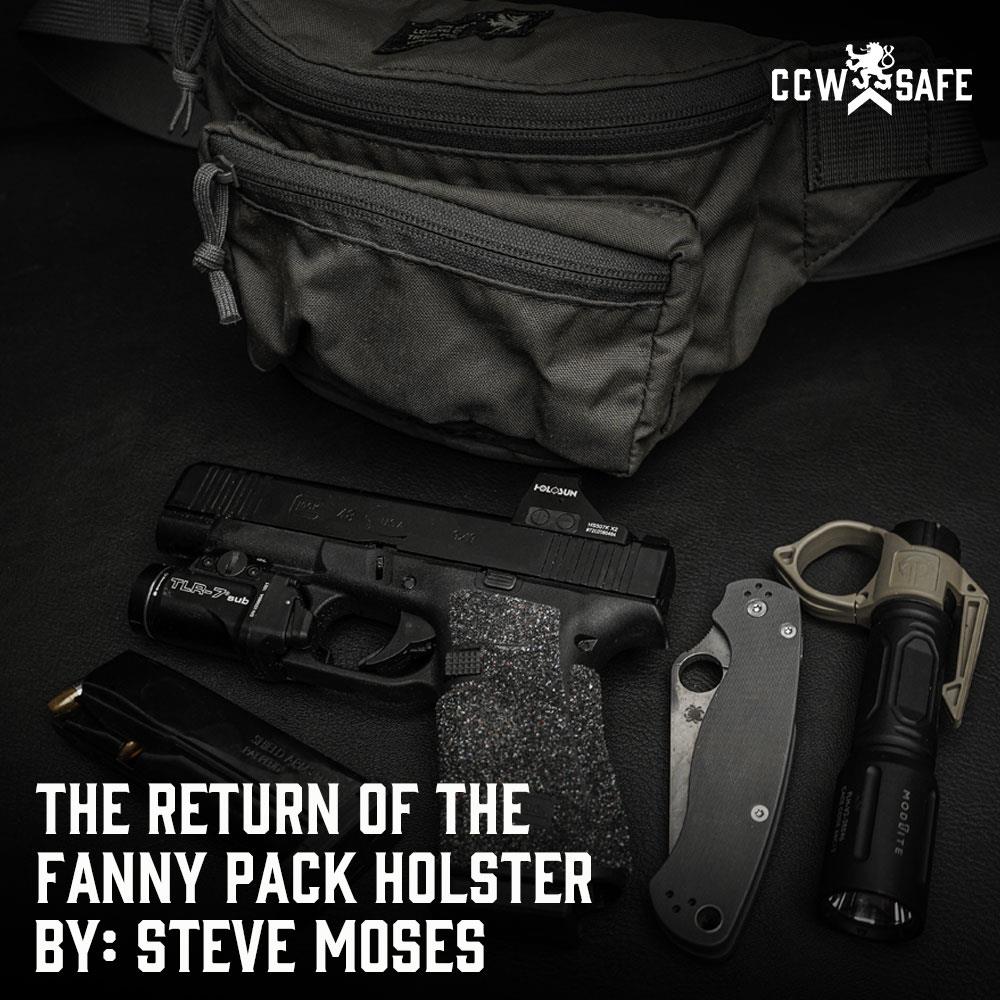
Posted on January 3, 2022
THE RETURN OF THE FANNY PACK HOLSTER
I started defensive handgun training in 1993 at the Texas Pistol Academy in Whitewright, Texas under the tutelage of owner, instructor, and former Special Forces sergeant Robert Duhon. At the time, the defensive handgun program consisted of two-day Basic, Intermediate, and Advanced Pistol courses. Duhon was a big advocate of using large fanny pack holsters for carrying steel-framed full-sized .45 ACP 1911 pistols, and his Advanced Pistol Course was largely based upon working out of a fanny pack holster.
While I saw certain benefits associated with occasional use of the fanny pack holster, I then preferred (and still do) carrying my handgun on my waistline whether on my hip or in the appendix position. We now know that civilians are more likely be to be injured and killed with hands, feet, and cutting instruments than with handguns, and that the ability to both quickly and timely draw and shoot accurately with a concealed handgun can be critically important if a criminal offender is armed with a handgun. It is easier to retain a handgun that is holstered than carried in a fanny pack, and it takes longer to draw a handgun from a fanny pack than it does from a holster. In addition, fanny pack carry at the time (mid-1990s) actually attracted the attention of others. My normal attire during that period was a business suit or Wrangler jeans, cowboy boots, and a tucked-in dress shirt. Regardless, I still owned a fanny pack holster during that time period. It was a convenient way to occasionally wear a holster when wearing gym shorts and sweatpants.
Since then, things have changed. I have exchanged the full-sized 1911 for smaller and lighter Glocks (my current favorite is the Glock 48) and as I age, I find that my body’s check engine light is constantly flashing at me. Several lower back surgeries and a double hernia surgery made traditional belt awkward at times, and while I was writing this article I was scheduled to undergo arthroscopic hip surgery on my dominant side. Fanny pack carry makes perfect sense in these situations. Another game changer is that fanny pack carry has become far more ubiquitous in 2020 thanks to high-profile celebrities and hipsters. Readers who want to confirm this are encouraged to simply Google “hipster fanny pack.” Those wanting to maintain a low-profile “Grey Man” appearance in public can now wear a fanny pack holster without getting the same attention that could be expected two decades ago.
Do my previous comments suggest that fanny pack carry should then be reserved for persons with certain medical issues only? My opinion is that is also ideal for other reasons, including the following:
- Cannot wear a belt and not interested in using an inside-the-waistband holster that clips onto an elastic waistband? Check out the fanny pack holster.
- Going to the gym for a hard workout? I have seen other gym members arrive wearing fanny packs, set them on the floor next to them while they worked out on a machine, and then pick it up when they moved to another machine. I personally do not do this because I have a phobia about even temporary off-body carry around others, but obviously others are okay with it.
- If there are children in the house or other adults who are best kept away from handguns, fanny pack carry is a convenient and comfortable way to keep a handgun on my person. Despite the low odds of having an intruder break into my residence while I was present, it has indeed happened to me before.
- I am a Texas licensed Personal Protection Officer Instructor. In Texas, you have to have Personal Protection Officer license in order to do executive protection. I was once asked by another executive protection specialist from another state if I had any suggestions for concealed carry for a driver on their team who was forced by circumstances to wear his concealed pistol on his hip. My suggestion was to transfer his pistol to a fanny pack holster while driving, and then revert to hip carry if his duties called for him or her to leave the vehicle. Just to clarify, the primary role of a driver under those circumstances is to drive, not shoot. However, there are a few circumstances in which the driver may need to get a gun into the fight fast. There are likely concealed carriers who spend a lot of time in vehicles that normally carry their handguns on their hip that feel the same way. This is at least one option if faster access to the concealed handgun while seated in the vehicle is deemed important.
- A reader contacted me personally and requested advice on how he might be better prepared to defend himself during long trips in his motor home. He was unable to belt carry because of significant back injuries and concerned about being robbed when he stopped at gas stations to fuel the motor home. I suggested two options. One, carry a small-framed handgun like a Glock 43 or Sig 365 in a pocket holster either in the front pocket of his pants or a coat pocket, or carry his preferred carry pistol in a fanny pack holster. An alternative handgun for pocket carry use is a small-framed snub-nosed revolver, but I primarily recommend those to experienced shooters who are willing to put in the range time in order to learn how to use them competently as they are markedly more difficult to shoot well.
A good fanny pack holster is well-made and offers storage space for a pistol magazine or revolver speed-strip and other items like cell phones, cash, and car keys. I prefer compact low-profile fanny packs that do not have a tactical or military appearance. I typically avoid bright colors that draw the eye. Some concealed carriers will adorn their fanny pack holsters with multiple patches associated with sports or locations they have visited in order make it look more benign. Again, discretion is suggested. I think their intent is valid but overdoing it can again draw unwanted attention. An intelligently designed fanny pack holster typically uses two zippers with attached tabs designed for gripping to secure the front of the fanny pack to the back. The concealed carrier should be able to grasp one of the zipper tabs with one hand, pull down, and cause the front of the fanny pack to fall away, exposing the concealed handgun. The handgun is typically located in a nylon holster that is secured to the back of the fanny pack by a Velcro attachment. The nylon holster is a must in my opinion. It keeps the handgun from falling out of the fanny pack, it keeps the handgun always in the same position, it positions the handgun properly for the quickest possible draw, and finally it covers the trigger guard which is necessary in order to avoid an inadvertent negligent discharge.
I purchased my current fanny pack some fifteen years ago at a Dallas, Texas gun show and am embarrassed to admit that I do not know the manufacturer. There are simply no labels attached to it anywhere. I can only say that it fits my needs well and I am happy with it, but I obviously cannot recommend it because I do not know where they can be found. I did a search on the internet looking for manufacturers of fanny pack holsters that concealed carriers might check out as long as they know that I have not had the opportunity to personally review any of their models. These manufacturers include, but are not limited to, Blackhawk, 5.11, DTOM, Roma, and Black Tactical. There are likely more.
In summary, concealed carriers might be well served by looking into fanny pack holsters with the understanding that there are both pros and cons. In my opinion, fanny pack holsters fit a specific niche, but there are times and occasions when a fanny pack holster might very well be the best possible way to keep a handgun on our person. While it is always important to manage distance from persons whose intent is unknown and avoid confrontation with others, it is especially so when using a fanny pack holster. However, with practice, presentation from a fanny pack can be done fairly quickly, and I can deploy a handgun as fast or faster from one than the average concealed carrier can deploy one from a concealed holster. The same should be true for most concealed carriers if they are willing to put in the practice time.
 |
Steve MosesSteve Moses has been a defensive firearms trainer for over 26 years and is a licensed Texas Personal Protection Officer with 7 years of experience performing as shift lead on a church security detail for a D/FW area metro-church. Steve is a co-owner and Director of Training for Palisade Training Group, LLC based in Dallas, Texas. Moses is a retired deputy constable and spent over 10 years on a multi-precinct Special Response Team. He owns multiple instructor certifications, including Rangemaster Advanced Handgun Instructor and Defensive Shotgun Instructor, Red Zone Knife Defense Instructor and Adaptive Striking Foundations Instructor, Modern Samurai Project Red Dot Sight Instructor, and State of Texas Personal Protection Officer Instructor. Steve holds a BJJ Brown Belt in Relson Gracie Jiu Jitsu. He is a content contributor for CCW Safe and writes weekly articles on various subjects of interest to concealed carriers. Moses shoots competitively and holds an IDPA Expert rating. Steve is an annual presenter at the Rangemaster Tactical Conference. |